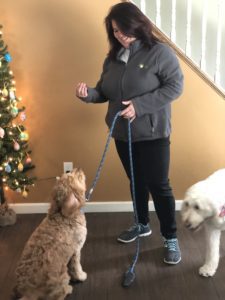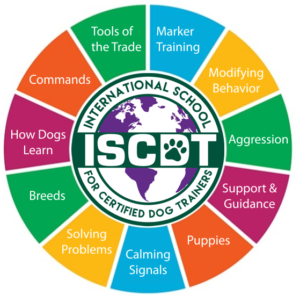From the moment we discover we are expecting a new baby, we prepare our world for the exciting arrival. We often forget to prepare an important member of our family — our dogs. They know something exciting is happening for their humans, but the details are scarce. Then, one day a strange being enters the house, bringing along with it strange smells, sounds and confusing behavior from the people the dog loves most.
How do we prepare the dog for the new family member? Below we have provided several tips for you to use in between prenatal visits and baby showers.
Basic Obedience
Before your baby is born, focus on leadership to ensure the pack is properly structured. Basic obedience training is a great place to begin. Once your dog learns basic commands such as sit, down, stay, come, leave it, off and place, reinforce these commands while cradling a realistic-looking doll. The exercise should include walking back and forth with the doll, simulating burping a baby, feeding it and sitting with the doll in your arms.
Once the dog is familiar with you cradling the doll, download recordings of a baby crying, gurgling, giggling, etc. and play the recording while you hold the doll. Gradually increase the volume of the recording with each lesson. The goal of this exercise is for the dog to remain relaxed during different scenarios. If the dog reacts poorly, move the dog further away from you and the doll and try again. When the dog is relaxed, gradually invite him to move closer and repeat the exercise.
After each training session, put the doll away in a safe place. Treat the doll the same way you would treat a real baby, so the dog knows it is not a toy.
Prohibit Jumping
Not only is jumping on people rude behavior, it can cause harm to your child. Discourage your dog from jumping, especially when someone is holding the doll. This way the dog exhibits proper behavior well before your baby arrives.
Discourage Bossy Behavior
It is important that you continue to make time for your dog after the baby’s arrival. If you can no longer go on daily walks or play in the yard, hire a dog walker to help. Dogs require mental stimulation and exercise to remain happy and healthy. It is good practice to interact with your dog while the baby is awake. Provide the dog with a special treat while the baby eats and speak to him while you care for the baby. While the baby is asleep, pay less attention to the dog. Take care of his basic needs, but limit playtime. This way he will look forward to the baby’s presence.
Curb bossy behavior. Let’s face it, sleep-deprived parents quickly lose patience with a dog that barks or paws them for attention. Dogs must learn to wait their turn. It is impossible for you to meet every need on his timeline.
Our baby is Off Limits to you. Over the years, we have heard people brag about their dog’s protective nature with the baby. They find it cute that the dog sleeps on the floor in the nursery guarding the crib. People laugh when the dog growls as family members approach the bassinet. This is not appropriate behavior. It is imperative that you communicate to your dog that the baby belongs to you and the dog must abide by your rules whenever the baby is around.
To help the dog understand the rules, the baby’s nursery should be off limits unless you invite him in. When you do allow him in the room, let him sniff around so he becomes accustomed to unfamiliar smells. After a reasonable amount of time, instruct the dog to leave the room.
Preparing for the Homecoming
When you pack your bags for the upcoming hospital stay, include a T-shirt, blanket or burp cloth. Swaddle the baby in the item so it has both the baby’s scent, as well as your own. Ask a family member to bring that item home from the hospital. Invite the dog to sniff the item while they hold it. Then instruct the dog to move away. By doing so, you are communicating to your dog that the item is yours and he requires your permission to sniff it. This exercise helps the dog create respect for rules relating to the baby.
Homecoming. The day you bring your bundle of joy home, ask a family member to bring the dog for a long walk so he can release energy. It’s best the dog is not in the home when you arrive.
When Mom arrives home, she should greet the dog without the baby in the room. Slowly introduce the baby. Although he’s familiar with the baby’s scent, he may not be ready for the whole package.
Meeting the baby. The dog should be on leash when he meets your newborn. Speak to him in a calm manner and allow him time to adjust. If he remains calm, he may gradually move closer to the baby (on a loose leash). If the dog appears agitated, remove him from the room and try again later.
Dogs are social and want to spend time with their family members. The ‘place’ command enables the dog to remain in the same room as the family, by settling into a special, out-of-the-way location.
Remember, Dogs are Animals
Most dog owners love their dogs like children. It is easy to forget they are animals. Remember, animals think and act differently than humans. Therefore, you should never leave your dog and baby unattended. He could accidentally hurt the baby by jumping on them or becoming aroused by crying and unexpected movement.
Do not believe that only large breed dogs are a danger to your baby. Small and toy-sized dogs can seriously injury too.
Just because your dog enjoys the company of children does not mean he will welcome a newborn. Training your dog before the baby’s arrival, will prepare you for unpredictable behavior.
Ahhhh! What do you mean an infant grows into a toddler?
Just when your fur baby gets used to the newborn, she grows into a curious baby. In addition to teaching the baby to be gentle, play with your dog’s ears, paws and tail. Gently tug on his fur to get him used to a baby’s touch.
ISCDT’s self-paced, 18-lesson, online course prepares you for a new career as a #dogtrainer. Your personal mentor helps build your skill through written assignments and video submissions of you working with #dogs. Visit our website to learn more: https://iscdt.com/product/iscdt-certified-dog-trainer-course/…
Article Written by Katie McKnight










